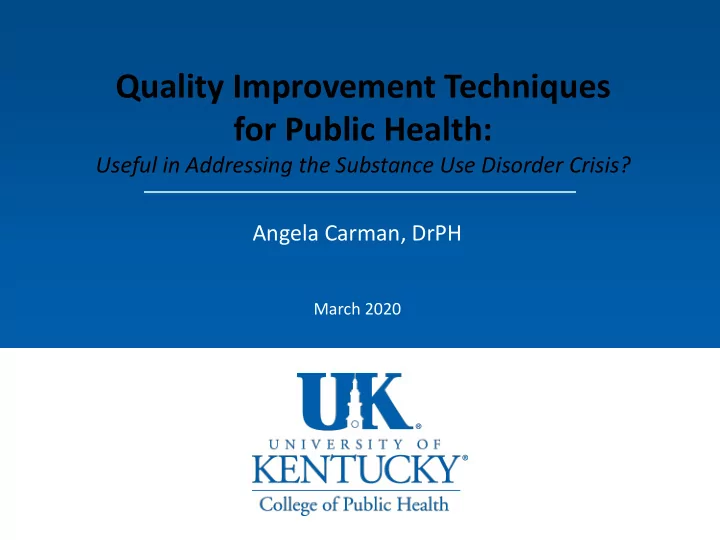

Quality Improvement Techniques for Public Health: Useful in Addressing the Substance Use Disorder Crisis? Angela Carman, DrPH March 2020
What is Quality Improvement? “Systematic problem solving required to develop and improve products” Dr. W. Edwards Deming “Big QI vs little qi”
The Opioid Epidemic in the United States • From 1999 to 2017, more than 700,000 people have died from a drug overdose. • Around 68% of the more than 70,200 drug overdose deaths in 2017 involved an opioid. • In 2017, the number of overdose deaths involving opioids (including prescription opioids and illegal opioids like heroin and illicitly manufactured fentanyl) was 6 times higher than in 1999. • On average, 130 Americans die every day from an opioid overdose. https://www.cdc.gov/drugoverdose/epidemic/index.html
PDCA/PDSA Process Plan Check/ 1. Identify and 7. Develop Improvement Study Prioritize Opportunities Theory/Idea 2. Develop AIM 1. Reflect on the Analysis 8. Develop Action Plan Statement 2. Document Problems, 3. Describe the Current Do Observation, and Process Lessons learned 1. Implement the 4. Collect Data on Improvement Act Current Process 2. Collect and Document Adopt Standardize 5. Identify All Possible the Data Causes Adapt Do 3. Document Problems, 6. Identify Potential Observations, and Lessons Improvements Abandon Plan Learned The ABC’s of PDCA, G. Gorenflo and J. Moran
Identify all Possible Causes Cause & Effect Diagrams – Construction Write the issue as a problem Effect statement on the right hand side of the page and draw a box around it with an arrow running to it. This issue is now the effect
Cause & Effect Diagrams – Construction: Generate ideasas to Header Header whatare the main causesof theeffect Label theseas the main Effect branch headers Organizesgroup knowledgeaboutcauses of a problem and display Header Header the information graphically
Cause and Effect Diagrams – Construction: Foreach main cause category brainstorm ideas Header Header as towhatare the related sub-causes that might effectour issue why why why Use the 5 Why techniques Effect when acause is identified why Keep repeating the question until noother causescan be identified Header Header List thesub-cause using arrows
Fishbone (Cause & Effect) Diagrams: 6 Common categories of causes
Practice • Step One: Mortality Morbidity – By table groups - Brainstorm risk factors/causes of Substance Use Disorder Mortality and Morbidity using a T-Chart
Practice • Step Two: – Select the list from either side Mortality of the T-Chart (mortality or morbidity) OR – Organize information into Morbidity a fishbone diagram
What we think vs What we know Evidence-based Literature Review – Causes/Risk Factors • Peer-reviewed literature • CDC • SAMHSA
Risk Factors/Effect – Substance Use Disorder
Uses of the Fishbone (Cause and Effect) - Assessing membership in the consortium - Focusing on the specific risk factor - Selecting evidence-based intervention(s) to target a specific risk factor
What is Working Around the Country?
CDC – What’s Working in the United States Evidence Based Strategies for Preventing Opioid Overdose 1. Targeted Naloxone Distribution 2. Medication Assisted Treatment 3. Academic Detailing 4. Eliminating Prior-Authorization Requirements for Medications for Opioid Use Disorder 5. Screening for Fentanyl in Routine Clinical Toxicology Settings 6. 911 Good Samaritan Laws 7. Naloxone Distribution in Treatment Centers and Criminal Justice Settings 8. MAT in Criminal Justice Settings and Upon Release 9. Initiating Buprenorphine-based MAT in Emergency Departments 10. Syringe Services Programs https://stacks.cdc.gov/view/cdc/59393
PDCA/PDSA Process Plan Check/ 1. Identify and 7. Develop Improvement Study Prioritize Opportunities Theory/Idea 2. Develop AIM 1. Reflect on the Analysis 8. Develop Action Plan Statement 2. Document Problems, 3. Describe the Current Do Observation, and Process Lessons learned 1. Implement the 4. Collect Data on Improvement Act Current Process 2. Collect and Document Adopt Standardize 5. Identify All Possible the Data Causes Adapt Do 3. Document Problems, 6. Identify Potential Observations, and Lessons Improvements Abandon Plan Learned The ABC’s of PDCA, G. Gorenflo and J. Moran
NEXT STEPS?
Recommend
More recommend